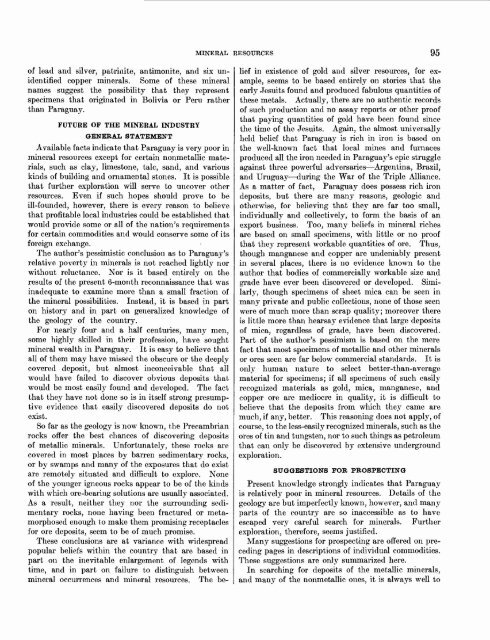Geology and Mineral Resources of Paraguay A Reconnaissance
Geology and Mineral Resources of Paraguay A Reconnaissance
Geology and Mineral Resources of Paraguay A Reconnaissance
- No tags were found...
You also want an ePaper? Increase the reach of your titles
YUMPU automatically turns print PDFs into web optimized ePapers that Google loves.
MINERAL RESOURCES 95<strong>of</strong> lead <strong>and</strong> silver, patrinite, antimonite, <strong>and</strong> six unidentifiedcopper minerals. Some <strong>of</strong> these mineralnames suggest the possibility that they representspecimens that originated in Bolivia or Peru ratherthan <strong>Paraguay</strong>.FUTURE OF THE MINERAL INDUSTRYGENERAL STATEMENTAvailable facts indicate that <strong>Paraguay</strong> is very poor inmineral resources except for certain nonmetallic materials,such as clay, limestone, talc, s<strong>and</strong>, <strong>and</strong> variouskinds <strong>of</strong> building <strong>and</strong> ornamental stones. It is possiblethat further exploration will serve to uncover otherresources. Even if such hopes should prove to beill-founded, however, there is every reason to believethat pr<strong>of</strong>itable local industries could be established thatwould provide some or all <strong>of</strong> the nation's requirementsfor certain commodities <strong>and</strong> would conserve some <strong>of</strong> itsforeign exchange.The author's pessimistic conclusion as to <strong>Paraguay</strong>'srelative poverty in minerals is not reached lightly norwithout reluctance. Nor is it based entirely on theresults <strong>of</strong> the present 6-month reconnaissance that wasinadequate to examine more than a small fraction <strong>of</strong>the mineral possibilities. Instead, it is based in parton history <strong>and</strong> in part on generalized knowledge <strong>of</strong>the geology <strong>of</strong> the country.For nearly four <strong>and</strong> a half centuries, many men,some highly skilled in their pr<strong>of</strong>ession, have soughtmineral wealth in <strong>Paraguay</strong>. It is easy to believe thatall <strong>of</strong> them may have missed the obscure or the deeplycovered deposit, but almost inconceivable that allwould have failed to discover obvious deposits thatwould be most easily found <strong>and</strong> developed. The factthat they have not done so is in itself strong presumptiveevidence that easily discovered deposits do notexist.So far as the geology is now known, the Precambrianrocks <strong>of</strong>fer the best chances <strong>of</strong> discovering deposits<strong>of</strong> metallic minerals. Unfortunately, these rocks arecovered in most places by barren sedimentary rocks,or by swamps <strong>and</strong> many <strong>of</strong> the exposures that do existare remotely situated <strong>and</strong> difficult to explore. None<strong>of</strong> the younger igneous rocks appear to be <strong>of</strong> the kindswith which ore-bearing solutions are usually associated.As a result, neither they nor the surrounding sedimentaryrocks, none having been fractured or metamorphosedenough to make them promising receptaclesfor ore deposits, seem to be <strong>of</strong> much promise.These conclusions are at variance with widespreadpopular beliefs within the country that are based inpart on the inevitable enlargement <strong>of</strong> legends withtime, <strong>and</strong> in part on failure to distinguish betweenmineral occurrences <strong>and</strong> mineral resources. The beliefin existence <strong>of</strong> gold <strong>and</strong> silver resources, for example,seems to be based entirely on stories that theearly Jesuits found <strong>and</strong> produced fabulous quantities <strong>of</strong>these metals. Actually, there are no authentic records<strong>of</strong> such production <strong>and</strong> no assay reports or other pro<strong>of</strong>that paying quantities <strong>of</strong> gold have been found sincethe time <strong>of</strong> the Jesuits. Again, the almost universallyheld belief that <strong>Paraguay</strong> is rich in iron is based onthe well-known fact that local mines <strong>and</strong> furnacesproduced all the iron needed in <strong>Paraguay</strong>'s epic struggleagainst three powerful adversaries Argentina, Brazil,<strong>and</strong> Uruguay during the War <strong>of</strong> the Triple Alliance.As a matter <strong>of</strong> fact, <strong>Paraguay</strong> does possess rich irondeposits, but there are many reasons, geologic <strong>and</strong>otherwise, for believing that they are far too small,individually <strong>and</strong> collectively, to form the basis <strong>of</strong> anexport business. Too, many beliefs in mineral richesare based on small specimens, with little or no pro<strong>of</strong>that they represent workable quantities <strong>of</strong> ore. Thus,though manganese <strong>and</strong> copper are undeniably presentin several places, there is no evidence known to theauthor that bodies <strong>of</strong> commercially workable size <strong>and</strong>grade have ever been discovered or developed. Similarly,though specimens <strong>of</strong> sheet mica can be seen inmany private <strong>and</strong> public collections, none <strong>of</strong> those seenwere <strong>of</strong> much more than scrap quality; moreover thereis little more than hearsay evidence that large deposits<strong>of</strong> mica, regardless <strong>of</strong> grade, have been discovered.Part <strong>of</strong> the author's pessimism is based on the merefact that most specimens <strong>of</strong> metallic <strong>and</strong> other mineralsor ores seen are far below commercial st<strong>and</strong>ards. It isonly human nature to select better-than-averagematerial for specimens; if all specimens <strong>of</strong> such easilyrecognized materials as gold, mica, manganese, <strong>and</strong>copper ore are mediocre in quality, it is difficult tobelieve that the deposits from which they came aremuch, if any, better. This reasoning does not apply, <strong>of</strong>course, to the less-easily recognized minerals, such as theores <strong>of</strong> tin <strong>and</strong> tungsten, nor to such things as petroleumthat can only be discovered by extensive undergroundexploration.SUGGESTIONS FOB PROSPECTINGPresent knowledge strongly indicates that <strong>Paraguay</strong>is relatively poor in mineral resources. Details <strong>of</strong> thegeology are but imperfectly known, however, <strong>and</strong> manyparts <strong>of</strong> the country are so inaccessible as to haveescaped very careful search for minerals. Furtherexploration, therefore, seems justified.Many suggestions for prospecting are <strong>of</strong>fered on precedingpages in descriptions <strong>of</strong> individual commodities.These suggestions are only summarized here.In searching for deposits <strong>of</strong> the metallic minerals,<strong>and</strong> many <strong>of</strong> the nonmetallic ones, it is always well to
















